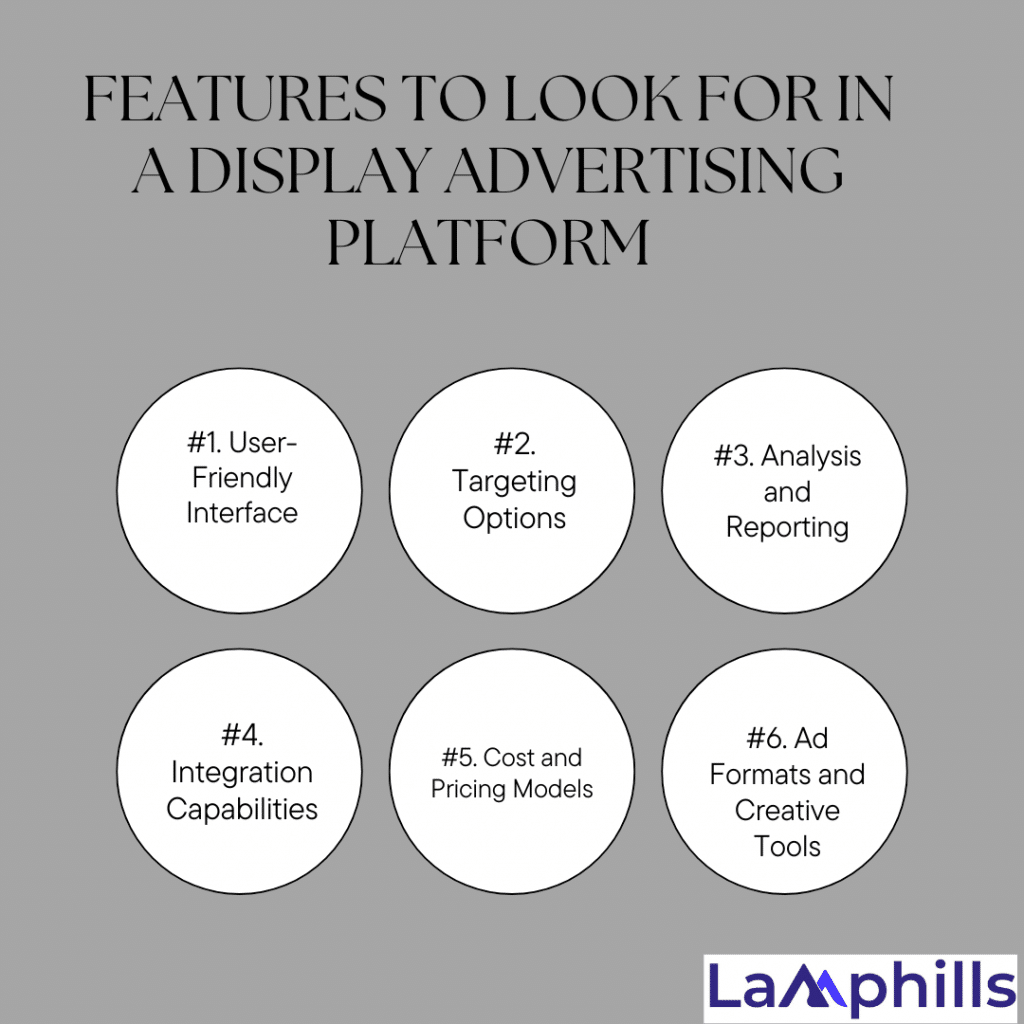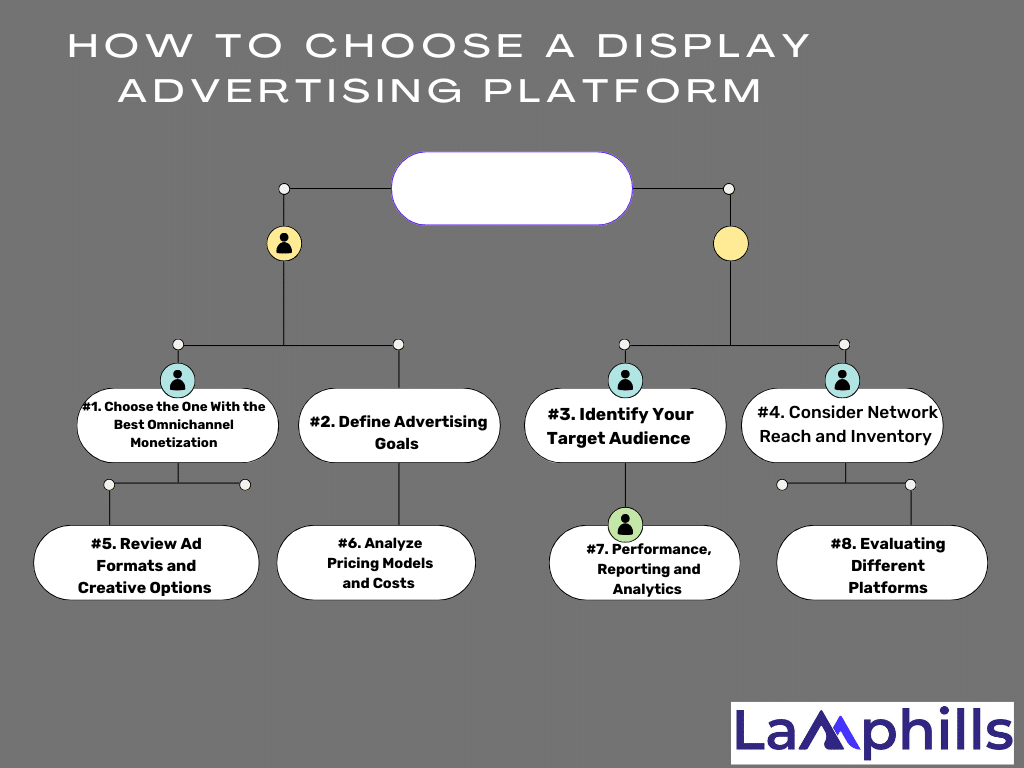Display advertising has transformed how firms approach digital advertising. Display advertising platforms, which use advanced algorithms and real-time bidding, enable firms to reach their target demographic with precision, scale, and efficiency. However, there are numerous platforms available in the market, and it can be overwhelming for businesses to choose the right one for their needs.
When I initially ventured into the world of digital marketing, the environment was daunting. I recall being tasked with establishing a display advertising campaign for a company I was working for. I was flooded with options, all promising exceptional reach, engagement, and ROI. It seemed like trying to pick the best wave amid a sea of options. After a few years, I’ve realized that choosing the best display advertising platform can make or break your campaign’s success.
In this article, I’ll explore the display advertising platforms that businesses should think about for their next campaign. Each advertising platform has its own set of features and benefits that can help businesses reach their advertising objectives, such as brand exposure, lead generation, or sales conversion.
Key Takeaways
- A user-friendly interface is crucial for efficient campaign management. Platforms with intuitive dashboards and clear navigation significantly enhance the user experience, reducing the learning curve and allowing marketers to focus on optimizing their campaigns.
- Effective targeting is essential for maximizing ad relevance and performance. Display advertising platforms should offer detailed audience segmentation, including behavioral, contextual, and demographic targeting, enabling advertisers to reach precisely the right audience.
- The flexibility of ad formats and the availability of creative tools are vital for crafting compelling advertisements. Platforms that support various ad formats, such as static banners, interactive videos, and rich media, allow marketers to create engaging and impactful ads that stand out.
- Seamless integration with existing marketing tools and the ability to scale with business growth are important features of a display advertising platform. Platforms that offer API access, third-party integrations, and support for various devices and channels ensure a cohesive marketing strategy and the flexibility to expand as needed.
What is Display Advertising?

You have seen display advertising before, even if you weren’t aware of it at the time. Display advertising is found on third-party websites and includes video, image, or text elements to promote items or services.
Display advertising is a type of online advertising that promotes items or services via the use of visuals like banners, photos, and videos. These advertisements appear on websites, social media platforms, and mobile apps in an attempt to capture the attention of potential clients.
It uses innovative technology and automated processes to buy and sell digital ad inventory. The procedure begins when an advertiser sets up their campaign parameters, such as target audience, budget, and ad creatives. Then, the advertiser connects to an advertising platform or a demand-side platform (DSP). After this, the DSP uses sophisticated algorithms and machine learning to analyze a vast amount of data in real time, including user behavior, preferences, and intent signals. Based on this data, the DSP determines the optimal bid price and which ad impressions to purchase.
This bidding procedure occurs in milliseconds when an ad impression becomes available on a publisher’s website or app. When a winning bid is determined, the advertiser’s ad is immediately displayed to the user.
What Is a Display Advertising Platform?
Display ads are adverts that appear on websites and apps, typically in the form of images, text, or videos. They are typically clickable and redirect viewers to a landing page, contact form, website, or other destination. They are automated solutions that simplify the purchase and sale of digital ad inventory. These platforms utilize advanced algorithms and machine learning to evaluate massive quantities of data and make real-time purchasing decisions.
Display advertising platforms allow advertisers to target the right audience with the right message, at the right time and place, by utilizing data on user demographics, behavior, and preferences. These platforms offer marketers a variety of ad formats and inventory possibilities, including display, video, mobile, and social media.
In other words, they are groupings of websites and applications that run display advertisements. Publishers use these networks to connect with advertisers and sell their ad inventory. This allows them to monetize content and website traffic without needing subscriptions or purchases from their users.
Key Features to Look for in a Display Advertising Platform

Here are a few features I search for when selecting any advertising platform
#1. User-Friendly Interface
A few years ago, I was working on a campaign for a non-profit. We chose a technology that promised excellent outcomes but required a steep learning curve. Navigating the interface felt like reading an old script, which substantially hindered our progress. A user-friendly interface is essential, particularly for marketers who must swiftly adjust and start campaigns. Look for platforms with simple dashboards and straightforward navigation.
#2. Targeting Options
One of my most successful campaigns targeted a specific audience: dog lovers looking for eco-friendly items. Our targeting options were precise enough to allow us to reach the specific folks we wanted. Effective targeting is critical for any display advertising platform. Ensure that it provides detailed audience segmentation, including behavioral. contextual, and demographic targeting, to maximize your ad’s relevance.
#3. Ad Formats and Creative Tools
During a holiday campaign for a retail client, we experimented with a variety of ad formats, including static banners and interactive videos. The versatility of our platform’s creative features enabled us to create captivating advertising that stood out. A solid display advertising platform should support several ad formats and provide creative capabilities to enable you to easily develop compelling ads.
#4. Analysis and Reporting
I previously worked with a customer that was wary of digital advertising. It wasn’t until we gave them precise metrics that they realized its usefulness. Comprehensive analytics and real-time reporting are essential for monitoring performance and making data-driven decisions. Look for platforms that provide clear reports and dashboards.
#5. Integration Capabilities
Integrating our display ads with our email marketing and CRM platforms transformed a campaign I managed last year. It streamlined our efforts and gave a comprehensive overview of our consumer contacts. Choose a platform that works easily with your current marketing tools, such as API access and third-party connections.
#6. Cost and Pricing Models
Budget limits are a constant concern, and knowing various pricing strategies is critical. I’ve used both cost-per-click (CPC) and cost-per-thousand-impressions (CPM) models, and each has its own set of perks. Examine the pricing structure of potential platforms to ensure that they fit within your budget and desired ROI.
How to Choose a Display Advertising Platform

If you plan to serve display ads on your website and/or apps, you will need a display ad network. However, you shouldn’t just go for any ad network that sounds good. Instead, ensure you know exactly what you need and make an informed decision. Let’s take a look at some of the most important features to look for.
#1. Choose the One With the Best Omnichannel Monetization
Examine the ad network’s targeting and optimization choices. Look for advanced targeting options that allow you to reach out to specific audiences based on demographics, interests, geolocation, or browsing habits. Ad performance can be improved by using optimization features such as real-time bidding (RTB) and audience segmentation.
You should choose an ad network that supports omnichannel monetization. In other words, it should allow you to monetize on a variety of platforms, operating systems, and devices. For example, if you have an OTT streaming service with a website and an OTT, CTV, or mobile app for different operating systems, your ad network should be able to offer display advertising on all of them. Even if you merely have a website to monetize, omnichannel capabilities will allow display ads to show up on various devices, from PCs to mobile phones.
#2. Define Advertising Goals
Begin by determining your primary objectives. Are you looking to raise brand awareness, generate leads, or boost sales? Understanding your objectives will assist you in selecting a platform that is appropriate for your business requirements.
Determine your aims and what you expect to achieve with display advertising. Are you wanting to raise brand awareness, drive website traffic, create leads, or increase conversions? Understanding your goals will assist you in evaluating ad networks based on their potential to offer results that are consistent with your objectives.
#3. Identify Your Target Audience
Proper audience targeting is a critical component of successful advertising efforts. Behavioral targeting allows you to target certain audiences based on their search history and online footprint. You can also segment an audience depending on their hobbies, age, region, and other criteria. Contextual targeting, on the other hand, ties an ad’s content to that of the website on which it appears.
Understand your target audience’s demographics, interests, and online behavior. Look for ad networks that provide targeting possibilities based on your audience profile. The capacity to target the appropriate audience is critical for effective advertising.
#4. Consider Network Reach and Inventory
Evaluate the ad network’s reach and the size and quality of its publisher network. A larger network can provide access to a broader audience, while a network with niche publishers may be more suitable for targeting specific demographics or interests. Additionally, consider the types of websites in the network to ensure they align with your brand and target audience.
#5. Review Ad Formats and Creative Options
Assess the ad formats and creative capabilities offered by the ad network. Consider whether they support the types of ads you want to display, such as static banners, rich media, videos, or interactive formats. Look for features that allow you to create engaging and visually appealing ads.
#6. Analyze Pricing Models and Costs
Understand the pricing models used by the ad network, such as CPM, CPC, or CPA. Compare the costs and value you can expect from different networks. Consider factors like minimum spending requirements, transparency in pricing, and whether the pricing aligns with your budget and expected return on investment (ROI).
#7. Performance, Reporting, and Analytics
One of the biggest advantages of digital over traditional advertising is the ability to track campaign performance in real-time. This also allows for adjustments during the campaign to maximize its performance. Ad optimization will also bring better results and more ad revenue.
#8. Evaluating Different Platforms
Compare popular display advertising platforms, such as Google Display Network, Facebook Ads, and programmatic platforms like The Trade Desk. Evaluate their features, pricing, and user reviews to determine the best fit for your business.
Tips for a Successful Platform Selection
- Seek Demos and Trials: Test the platforms before committing.
- Read Reviews: Look for testimonials and expert opinions.
- Consider Scalability: Ensure the platform can grow with your business.
Display Advertising Platform: Types
Advertising platforms address this issue for both publishers and advertisers. Publishers benefit from auctioning ad space to millions of advertisers worldwide, which helps optimize advertising profits. Advertisers benefit from increased reach and the ability to use data to target specific audiences. When done correctly, it results in increased profits for both sides and who doesn’t appreciate that?
But, if you’re seeking new ways to promote your business, display advertising could be a great choice. There are many options, therefore I’ve produced a list of the best display advertising platforms to help you decide. Ready to learn more? Let’s get started with an explanation.
#1. Google ADX

Google ADX is currently the internet’s largest and most popular ad exchange. Its Display Network includes more than 2 million websites and apps that provide display adverts. The ad supply is high-quality because Google has tight rules for its advertisers.
However, publishers must also meet these high requirements. For example, to be a part of the Google ADX network, your website must have at least 5 million active users each month.
Aside from ad supply and demand quality and network durability, one of Google ADX’s most appealing features is its versatility. In other words, Google provides a wide range of ad types for various purposes. Whether you want to improve brand recognition, generate leads, or educate your audience, Google ADX has a solution for you.
In terms of payment options, the network supports three of the most common models — CPC (cost per click), CPM (cost per mille), and CPA (cost per acquisition).
#2. Clickadu
Clickadu, a complete online advertising platform, has been operational for more than a decade. It boasts a large, global network of publications and marketers. The platform ensures a high fill rate and some of the greatest CPMs on the market.
Clickadu’s publishers have access to secure, clean ads from exclusive advertisers via a simple, user-friendly self-serve platform. Some of the most crucial tools and features are automated payouts, detailed analytics, and extensive optimization and management capabilities.
Key Features:
- User-friendly self-serve platform
- Detailed audience targeting options
- Fraud and bot filtering system
- Easy real-time optimization tools
#3. LinkedIn Ads

LinkedIn Ads is the greatest display ad platform for organizations that want to reach and engage their exact target audience. With over 722 million users globally, LinkedIn provides an unrivaled opportunity for advertising to engage with professionals and decision-makers across industries.
LinkedIn Ads distinguishes out due to its superior targeting possibilities. Advertisers can target specific users based on several variables, including job title, industry, company size, and region. This level of detail allows firms to generate extremely relevant and tailored adverts, increasing the possibility of conversion.
Furthermore, LinkedIn Ads provides a variety of ad forms, including sponsored content, sponsored messaging, and display ads. Each style has distinct advantages and may be tailored to a company’s specific needs. With such variety in ad options, LinkedIn Ads can accommodate various campaign objectives, whether building brand awareness, generating leads, or driving website traffic.
#4. Amazon Advertising

Amazon Advertising is a programmatic advertising network that provides a variety of benefits to advertisers. One of the primary advantages of Amazon Advertising is its vast audience. With over 310 million active customer accounts worldwide, Amazon provides advertising with a large range of potential customers.
Amazon Advertising provides advanced targeting solutions that leverage Amazon’s massive consumer data set to help advertisers reach their target market. Advertisers can use the platform to target customers based on a variety of criteria, such as search queries, previous purchases, and browsing behavior. With this level of accuracy, businesses may create highly relevant, personalized ads that appeal to their target population.
Additionally, Amazon Advertising offers a variety of ad styles, including sponsored items, brands, and display ads. Each model has particular advantages and can be tailored to a business’s needs.
One of the most significant benefits of Amazon Advertising is its capacity to increase sales. Advertisers can use the platform’s product-focused ad formats to promote their products to Amazon users who are actively shopping for related items. This method can enhance conversion rates and drive sales for businesses.
Finally, Amazon Advertising offers powerful analytics and reporting tools to help advertisers track campaign performance and modify their ads for better results. This data-driven strategy can help organizations fine-tune their targeting and messaging to improve campaign outcomes and ROI.
#5. Airnow Media
Airnow Media, formerly known as AirPush, is a demand-side platform that is part of Airnow’s mobile app monetization platform. It works as an advertising partner for mobile-based advertisers. In other words, it mostly provides display (and other) adverts to mobile apps and browsers, however, it also supports CTV advertising. Airnow Media has a network of more than 150,000 opt-in apps. This is a display advertising platform that supports real-time bidding. It includes facilities for fully configurable ad formats, comprehensive audience targeting, and real-time performance tracking and reporting.
Key Features:
- Mobile-first display advertising platform
- Robust demand-side platform
- Real-time performance tracking
- Ad optimization tools
- Programmatic and real-time bidding
- Ad network of over 150,000 apps
#6. Leadbolt

Leadbolt, an award-winning mobile-first ad network, offers an SDK for developers to easily integrate ad-based mobile app monetization. With thousands of advertisers using their network, Leadbolt has seen up to a 400% increase in eCPM in some case studies. The platform also supports a wide range of ad placements and formats, maximizing monetization opportunities.
Key Features:
- Built-in, AI-powered ad optimization tools
- Support for direct deals
- Crypto-powered programmatic advertising
- A wide variety of ad placements and formats
- Detailed performance reports and analytics
#7. Epom

Epom is a great beginner-friendly ad network that comes with a free trial for advertisers. It has a full stack of basic features any good ad network should have, such as detailed analytics and performance tracking, ad optimization toolsets, real-time bidding support, and more.
Epom can serve ads across various devices, operating systems, and platforms. Whether you want to monetize your mobile app, website, or video content, Epom has what you need. Lastly, the platform supports over 30 different rich media formats.
Key Features:
- Beginner-friendly advertising platform
- Over 30 rich media formats supported
- Omnichannel advertising support
- Detailed, unified, and customizable performance reports
- Advanced ad optimization and audience targeting options
- Over 60 existing DSP integrations
#8. Google AdSense
Google AdSense is one of the world’s largest display advertising networks. It serves approximately 2 million marketers and billions of customers. It’s also extremely successful for boosting traffic to websites.
Google AdSense, one of the world’s most famous ad networks, holds its advertisers to high-quality criteria. Those tight rules may appear ridiculous at times, but they are in place to ensure that only genuine advertisers use Google AdSense.
Google does not only deal with websites; they also deliver Google Ads to apps and other mobile-based programs, allowing you to reach the broadest potential audience. To begin advertising using AdSense, simply go to Google’s website and follow the steps.
Then, you’ll have to create high-quality ads that entice users to click on your site. Those ads should follow all standard practices along with Google AdSense best practices. By adhering to both of those standards, you’re sure to create outstanding ads that bring customers to your site.
#9. AdPushup

AdPushup is one of the largest display advertising networks. Instead, it serves a much broader purpose. AdPushup touts itself as a publisher-focused platform that aids in revenue optimization because its features are precisely linked with that goal, hence catering to publishers’ requirements.
If you’re just getting started with ad monetization, AdPushup is the right fit. They do not have a minimum traffic threshold, but they only work with websites that already generate $5,000 per month in advertising revenue.
AdPushup provides a wide range of tools organized into three pricing options depending on revenue sharing. These blueprints are packed with useful features. You will obtain access to Google ADX and AdSense, allowing you to use their advertising networks. It also provides managed header bidding, comprehensive revenue reports, ad optimization, and efficient management functionalities, among other offerings.
#10. MoneTag (Formerly PropellerAds)
MoneTag, previously known as PropellerAds, is a well-known display ad network with strict content control methods. Each campaign is manually vetted to ensure the highest quality and safety. Furthermore, Monetag guarantees excellent ad fill rates and ad yield for publishers.
Furthermore, Monetag provides essential features expected of a top-tier ad network, such as comprehensive analytics, real-time reporting capabilities, robust ad optimization tools, AdSense compatibility, advanced AdBlock bypass technology, and additional functionalities to help advertisers and publishers alike.
Benefits Of Using Display Advertising Platforms

Why do marketers love display advertising platforms? Because there are so many benefits, like:
#1. Targeting Specific Audiences
One of the main benefits of display advertising is the ability to target particular audiences. This can be done by targeting age, gender, location, behavior, or interest.
#2. Better ROI
One of my favorite success stories is a campaign for an e-commerce client. By regularly monitoring performance metrics and making data-driven modifications, we increased ROI by 50%. Display advertising systems offer the tools you need to track and optimize your campaigns efficiently. Display advertising platforms can help you get a higher return on investment (ROI) by allowing you to target your budget to the most effective locations.
#3. Greater Reach
A few months ago, I ran a campaign for a local bakery. By using a display advertising platform, we expanded their reach beyond the local community, attracting customers from neighboring towns. Display advertising can significantly boost your brand’s visibility, helping you reach a broader audience. This advertising helps you reach a large audience with your ad campaigns because display advertising is not limited to one specific site or network.
#4. Personalization
By using data insights, the best platforms allow advertisers to deliver highly personalized and relevant ads to specific users, leading to improved engagement and response rates.
#5. Transparency
Advertising platforms provide advertisers with access to detailed reporting and analytics, allowing them to track ad performance, measure return on investment, and make data-driven optimizations.
#6. Cross-Channel Advertising
These platforms facilitate seamless integration across multiple devices and channels, including desktop, mobile, and connected TV, ensuring consistent brand messaging and visibility.
#7. A/B Testing
Advertisers can compare ad creatives, messaging, and targeting techniques using A/B testing, which is made possible by advertising platforms, to find the most successful strategy.
Overall, there are many advantages to using the best display advertising platforms, such as improved reach and scale, flexibility and control, real-time optimizations, enhanced efficiency, cost-effectiveness, advanced targeting capabilities, personalization, transparency, and cross-channel advertising.
What is programmatic marketing?
Programmatic marketing is a data-driven strategy that uses automated technology like artificial intelligence, machine learning, and algorithms to target particular audiences with relevant adverts in real time. Through the use of a real-time bidding system, digital advertising space is bought and sold, giving marketers the ability to precisely and extensively reach their target audience across a variety of channels and devices.
What is an ad exchange?
An ad exchange is a digital marketplace that allows advertisers and publishers to buy and sell advertising space through an auction-based system in real-time, using data and algorithms to match the right ad to the right user at the right time, enabling more efficient and targeted advertising.
Is Google Display Network an ad network?
Yes, Google Display Network is an ad network for display advertisements. It features millions of websites where it can serve various types of display ads.
What does display mean in marketing?
In marketing, display refers to advertisements that show up on websites, social media, and applications in the form of an image, video, or text. Display marketing is great for raising brand awareness, generating leads and conversions, and remarketing.
Conclusion
For each marketer, selecting the best display advertising platform is essential. Choose a platform that fits your demands and produces effective campaigns by taking into account important characteristics like targeting possibilities, integration capabilities, and user-friendly interfaces. Thus, consider your options carefully and make a well-informed decision.






